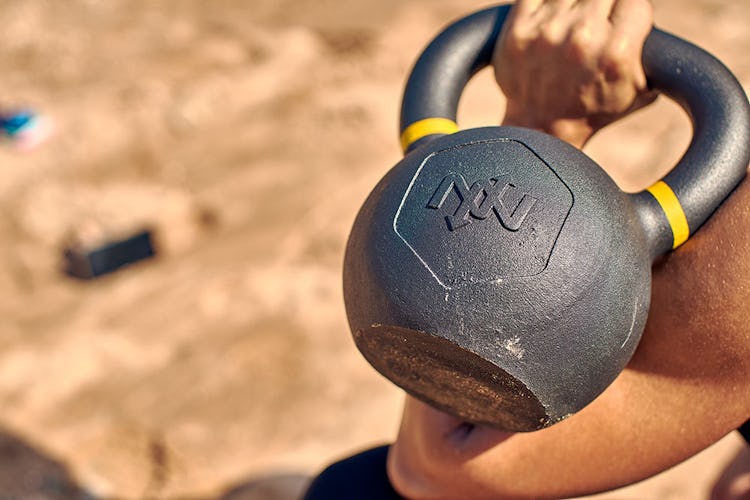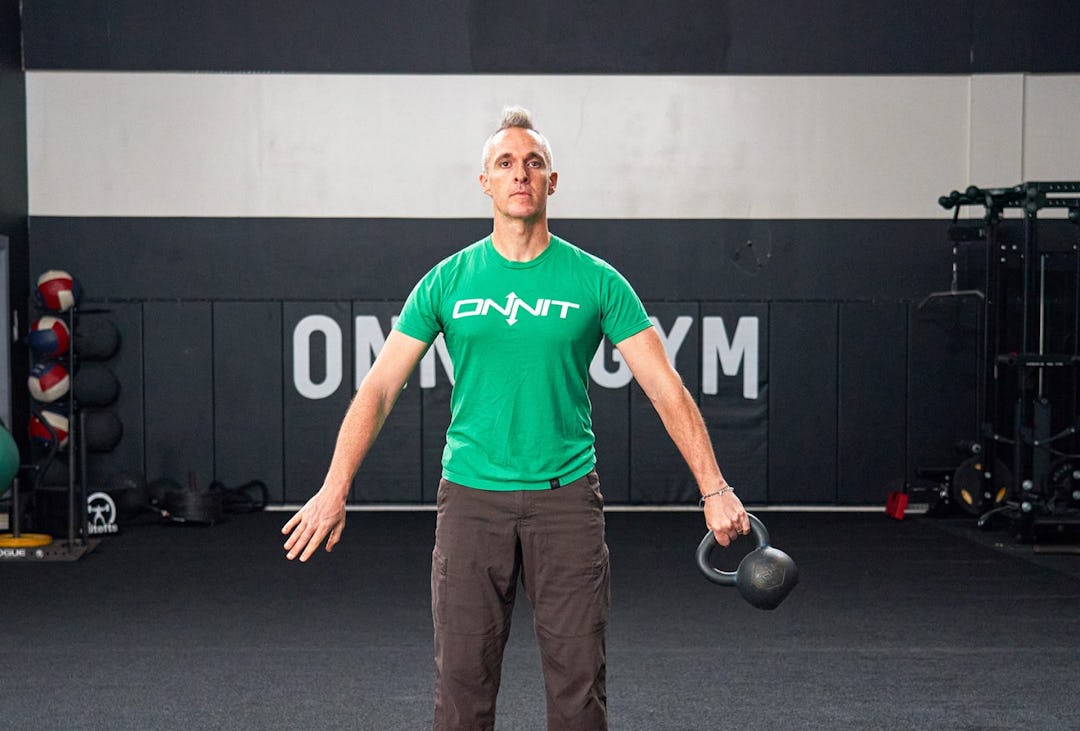At first glance, the kettlebell around the world exercise might seem simple, and maybe even goofy: you pass a kettlebell around your body in a circular motion. Heck, you say, a child could do that. But when you try it, you’ll see that it works muscles you never thought of in ways you never have, and it’s a necessary stepping stone to flashier, more sophisticated training like kettlebell flows and complexes.
Here’s a complete guide to the kettlebell around the world, from how to master to the movement to the whole world of movement it can unlock for you.
What Is The Kettlebell Around The World?
The kettlebell around the world, also called a hip halo by some coaches, has you moving a kettlebell around your body in a circular pattern, switching from one hand to the next. You’re allowed to use momentum so that the kettlebell flows smoothly through the transitions, but you have to control it—the weight can’t touch any part of your body (aside from your hands).
Here’s how to do it.
(See 01:02 in the video.)
Step 1. Stand very tall holding a light kettlebell (about 4–7 kilos/8–16 pounds) in one hand. Hold the bell at the far edge of the handle so you leave space for the other hand to grasp it easily. Retract your neck and tuck your chin, draw your shoulders back so your chest is proud, and tuck your tailbone under slightly so that your pelvis is level with the floor. You should feel like your posture is perfect. Now brace your core and hold this position throughout the exercise.
Step 2. Set the kettlebell in motion around your body (either direction, clockwise or counter-clockwise, is fine). When the kettlebell is directly in front of your body, switch it over to the other hand, and when it comes around directly behind your body, switch back. Move fast enough that you get some momentum going, but don’t try to rush it—set a steady rhythm.
Keep your arms straight the whole time. “Allowing bend in the elbows will cause your arms to get tired,” says Shane Heins, Onnit’s Director of Fitness Education.
It’s important to maintain your posture and balance throughout the movement. As you get more experienced and graduate to bigger kettlebells, this will become more challenging, so focus on staying tall and braced from the very beginning. Heins suggests placing a small box or other object between your feet and squeezing it in order to train you to keep your thighs tense—this will help you maintain stability.
You can perform the around the world for reps or time (for example, 30 seconds straight), but make sure you work it in both directions. So if you do 5 reps clockwise, immediately follow up with 5 reps counter-clockwise, so you build balanced strength.
Around The World Kettlebell Benefits

That circular motion accomplishes much more than meets the eye, and you’ll feel it all as soon as you start doing the movement (correctly, that is). Controlling the kettlebell’s path and momentum while keeping good posture trains the core and a bunch of other stabilizer muscles hard. (What else is going to keep you from bending or twisting as the weight travels away from your center of gravity?) Your wrist and forearm muscles have to clench the handle to prevent the weight from slipping away, so the around the world works your grip strength too.
On top of that, the centrifugal force you generate with the around the world creates a pulling effect that tractions out the shoulders, elbows and wrists. This really feels great, especially if you have years of heavy, joint-compressive lifting under your belt, and can arguably help to prevent injury and speed recovery from other strength-training workouts. Decompressive weight training, Heins says, is often overlooked and very valuable: controlling a weight as it pulls on your joints strengthens them, just as lifting a weight that compresses your joints does.
If you have athletic ambitions, or just want to get good at more advanced kettlebell training, the around the world should be a staple in your programs, as it works eye-hand coordination and balance. Over time, you’ll develop a better sense of where the kettlebell is in space around you, and you’ll be able to make the hand offs quicker and more smoothly.
Sophisticated kettlebell routines require you to change direction quickly and express strength in all the different planes of motion. Kettlebell flows, where you transition from one exercise to another, such as a clean to a squat and then rotational press, are an example of this. The kettlebell around the world lays the groundwork for this level of skill, helping you get comfortable with moving a weight 360 degrees around your body. You’ll have a hard time getting the hang of cleans, snatches, and twisting motions without mastering the around the world as a pre-req.
What Muscles Do Kettlebell Around The Worlds Use?
To list them all would take more words than we have the patience to write (and, presumably, more than you’d have the patience to read), but take our word that the deltoids, core (rectus abdominis, olbiques, transversus abdominis), wrist flexors and extensors, spinal erectors, quads, glutes, and various muscles in the hips on down will be engaged in every revolution of the around the world.
What Weight Kettlebell Should I Use?
When you’re starting out with the around the world, go light to get the form down. A 3–7 kilogram bell (8–16 pounds) is perfect. Once you’ve mastered the technique, you can still get a lot out of light weight, but you’re also welcome to increase the load if you want to make the exercise more of a core and grip workout. A 24–28 kilo bell (53–62 pounds) will be very challenging.
The around the world can serve many different functions and fit into your workouts in several ways. You can use a light bell in your warmup to jumpstart your core and hips, activating those muscles for better firing during the heavier or more explosive training to come. You can also add the around the world to a mix of other exercises for a battery that zeroes in on the core—do this at the end of a session for some extra work, or on an “off” day. The around the world can also be done between sets of kettlebell or conventional strength exercises for some active recovery. Think: you’re giving your muscles and nervous system a rest, but you’re still doing a little work to burn more calories, keep your heart rate up and build some conditioning, and stay warm. Heins particularly likes the around the world between sets of overhead pressing, as it will decompress your shoulders and elbows, and single-leg work.
Light around the worlds should be done for 3 sets of 20 reps, or 30 seconds in each direction, while a heavier bell can be used for 5 sets of 4–6 reps each direction.
How To Stretch Before Exercising?
Use the following mobility sequence from Heins (demonstrated in the video below) to prepare your hips for the around the world, or any other lower-body focused workout you have planned. Perform the movements as a circuit, completing one set for each in sequence and then repeating for 2–3 total rounds.
1. Kneeling Hip Flexor Stretch, 12 reps per side
2. Standing Knee Circle, 5 reps each direction, each leg
3. Spit-Stance Hip Coil (no weight), 12 reps each side
4. Ankle Spring Primer, 5 reps each side
BONUS: Thai Chi Knee Twist, 60 seconds each direction
Kettlebell Exercise Alternatives
You’ll be able to better see how the around the world translates to fancier kettlebell movements and sports when you move on to its progressions. As soon as you have the basic around the world down, try one of these variants.
Around The World With Hand Catch
(See 01:56 in the Kettlebell Around the World video)
This move takes the rotation from your hips up to your shoulders, making it a great exercise for full-body power. It mimics the mechanics of throwing a punch or a shotput, training you to coil through your core and stabilize your body with your hips.
Step 1. Perform the around the world as normal to get some momentum. Then, when you’re ready, bend your working arm to lift the kettlebell up to your opposite shoulder.
Step 2. Catch the bell with your free hand, bracing your core so you absorb the force. If you’re using a bigger kettlebell, you may have to allow your torso to rotate a bit in order to slow the kettlebell down on the catch—that’s OK, as this is how you move in real life. Now redirect the force by gently pushing the kettlebell back down and circling your body in the opposite direction.
Once you’ve got the hang of that, you can alternate catches on each rep. That is, circle your body clockwise and catch with the right hand, and then immediately circle counter-clockwise and catch with the left.
Step-Back Hip Coil
(See 03:38 in the video)
If you watched the video on how to warm up above, you recognize this exercise already. Here, it’s done with the kettlebell for strength and power (where as, done unloaded, it’s just a really great mobility drill). The step-back hip coil progression keeps the movement of the around the world at your hips but really allows you to practice transferring power between legs. It looks like a speed skater pushing off from one leg on the ice, loading up for a puck pass in hockey, or any number of other movements that require lower-body power.
Step 1. Perform the around the world as normal. Let’s say you’re moving counter-clockwise with the kettlebell in your right hand. As you transition the bell to your left hand, step back with your right leg and create a long line from your leg through your spine to the top of your head as you bend slightly at the hips (you can keep your heel elevated and only touch down with the ball of your foot). This will help you decelerate the kettlebell. Make sure your lower back stays neutral and does not round forward as you bend at the hips.
Step 2. Step forward again as you reverse the direction of the kettlebell and repeat on the other side. As with the around the world with hand catch, you can take your time doing a few revolutions with the bell before you coil on the other side.
Heins notes that the step-back hip coil works your hip in internal rotation, which is an oft-neglected movement pattern and very important for overall hip and lower-back health. An inability to move your hip well internally can cause the lower back to take over some movements, and that can lead to pain, so the step-back hip coil doubles as a prehab exercise.

)





